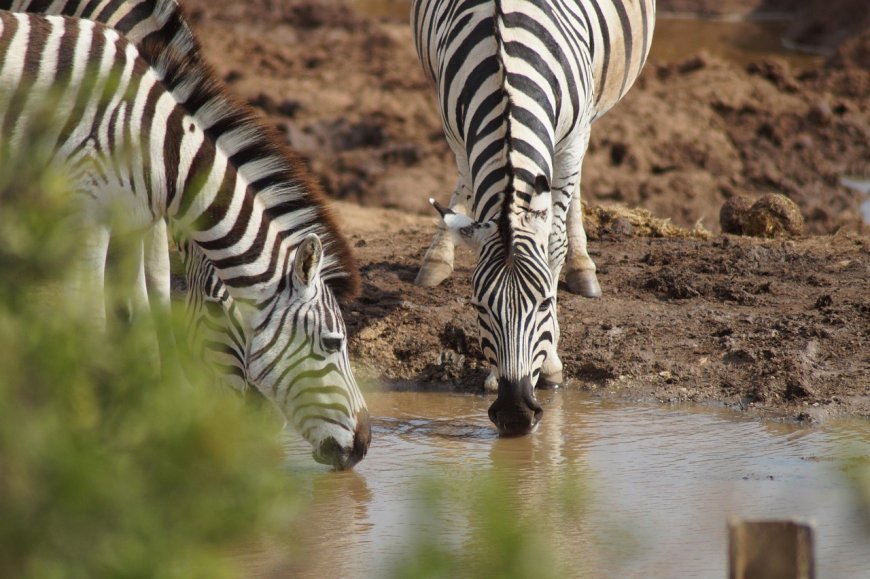Zebras: Striped Wonders of the African Plains – Facts, Adaptations, and Conservation
Learn about zebras, their iconic black-and-white stripes, habitats, diet, behavior, and conservation status. Discover fascinating facts for students and young animal lovers.

🦓 Zebras: Striped Wonders of the African Plains – Facts, Habitat, and Adaptations
Introduction
Zebras are among the most famous animals in the world, instantly recognized by their striking black-and-white stripes. They belong to the horse family, but unlike horses, zebras have never been truly domesticated. These animals live mainly on the grasslands and savannas of Africa, where their stripes help them hide, stay cool, and avoid biting insects. In this article, you will discover how zebras survive in the wild, what they eat, how they raise their young, and why conservation is important to keep them safe for the future.
Scientific Classification
Here is how scientists classify zebras:
- Kingdom: Animalia
- Phylum: Chordata
- Class: Mammalia
- Order: Perissodactyla (odd-toed ungulates)
- Family: Equidae (horse family)
- Genus: Equus
- Species:
- Equus quagga (Plains Zebra)
- Equus grevyi (Grevy’s Zebra)
- Equus zebra (Mountain Zebra)
Description and Adaptations
Zebras are medium-to-large herbivores with a body shape similar to a pony or small horse. Adults typically weigh between 500 and 900 pounds and stand about 4 to 5 feet tall at the shoulder.
Unique Adaptations:
- Stripes: Each zebra has a unique stripe pattern. Stripes help in:
- Camouflage: Confusing predators, especially when zebras stand together.
- Temperature control: Black and white stripes may create air currents that help with cooling.
- Pest control: Biting flies dislike landing on stripes.
- Strong teeth and jaws: Ideal for chewing tough grasses.
- Keen senses: Excellent hearing and vision for spotting predators.
- Speed and strength: Zebras can gallop up to 65 km/h (40 mph) and deliver powerful kicks to defend themselves.
Habitat and Range
Different species of zebras live in different parts of Africa:
- Plains Zebra: Found in grasslands, savannas, and open woodlands from eastern to southern Africa.
- Grevy’s Zebra: Lives in semi-arid grasslands and scrublands of Kenya and Ethiopia.
- Mountain Zebra: Prefers hilly and mountainous terrain in Namibia and South Africa.
Zebras need areas with plenty of grass and access to water sources. During dry seasons, some herds travel hundreds of miles to find food and water.
Diet and Feeding Behaviors
Zebras are herbivores, and about 90% of their diet consists of grasses. They will also nibble on leaves, bark, and shrubs when grass is scarce.
Feeding habits:
- Grazing: They graze for up to 18 hours a day.
- Selective grazing: Zebras prefer short, young grass but can eat taller, rougher grass that other grazers avoid.
- Migration: In regions like the Serengeti, plains zebras migrate in large herds to follow fresh grazing areas.
Unlike predators, zebras don’t hunt other animals; instead, they are prey for lions, hyenas, cheetahs, and wild dogs.
Reproduction and Nesting
Female zebras (mares) usually give birth to one foal at a time, after a gestation period lasting about 12 to 13 months.
Foal Characteristics:
- Born with brown and white stripes that darken as they grow.
- Able to stand within minutes and run within an hour.
- Nurse for 6–12 months.
Social Structure:
- Plains and Mountain zebras: Live in family groups called harems, led by a stallion.
- Grevy’s zebras: More solitary, with males defending territories and females moving between them.
Zebras don’t build nests; instead, foals stay close to their mothers in open terrain where they can see danger approaching.
Conservation Status
Zebra populations are declining due to:
- Habitat loss: Expansion of farms and settlements.
- Hunting and poaching: For hides and meat.
- Competition with livestock: Reduced grazing areas and water.
IUCN Conservation Status:
- Plains Zebra: Near Threatened.
- Grevy’s Zebra: Endangered.
- Mountain Zebra: Vulnerable.
Conservation groups work to:
- Protect natural habitats.
- Create wildlife corridors.
- Educate local communities.
- Enforce anti-poaching laws.
Fun Facts
- A zebra’s stripes are as unique as your fingerprints.
- Zebras sleep standing up.
- The skin beneath their fur is black.
- The Romans called them “hippotigris,” which means “horse tiger.”
- A group of zebras is called a dazzle or zeal.
- Some zebras have “shadow stripes,” faint brownish bands between the main stripes.
Vocabulary List
| Word | Definition |
|---|---|
| Herbivore | An animal that eats only plants. |
| Camouflage | The ability to blend in with surroundings to avoid being seen. |
| Predator | An animal that hunts and eats other animals. |
| Gestation | The period of development inside the mother before birth. |
| Harem | A social group with one male and several females and their young. |
| Migration | Seasonal movement of animals from one region to another. |
| Semi-arid | A region with light rainfall and dry conditions. |
| Conservation | The protection and careful management of the environment and wildlife. |
| Adaptation | A trait that helps an animal survive in its environment. |
| Ecosystem | A community of living things interacting with their environment. |
Kid-Friendly Summary
Zebras are special animals with black-and-white stripes living in Africa. There are three types: Plains, Grevy’s, and Mountain zebras. Each zebra has a one-of-a-kind stripe pattern that helps it hide, stay cool, and keep bugs away. Zebras mostly eat grass and live together in groups for protection. Baby zebras can run just an hour after being born! Today, many zebras are in danger because their homes are disappearing and some people hunt them. That’s why it’s important to protect zebras and keep their grasslands safe.




















































